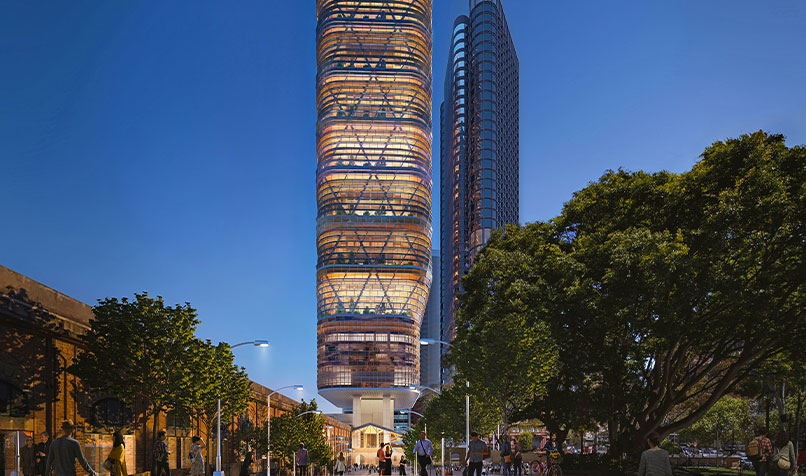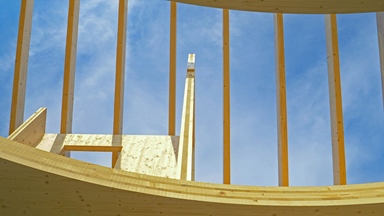Loading component...
At a glance
- Globally cities face a critical shortage of two billion affordable homes by 2100.
- Australia’s Green Building Council is driving scalable solutions to reconcile housing demand with emissions cuts.
- Barriers persist in outdated valuation models and fragmented policies.
It is a tale of too many cities. On the one hand, the World Bank estimates 80 per cent of the world’s cities do not have adequate affordable housing options. This means that two billion homes need to be built over the next 75 years — 96,000 new and affordable homes every day.
At the same time, these homes must be built without exacerbating global emissions. According to the World Green Building Council, buildings produce 39 per cent of global energy-related carbon emissions, of which 11 per cent come from materials and construction.
In Australia, where concrete, steel and aluminium account for nearly 70 per cent of buildings’ embodied carbon, decarbonising construction while scaling housing supply has become a contested space. The argument is that it is not possible to build housing on a mass scale while also lowering emissions.
The Green Building Council of Australia (GBCA) and other experts disagree. The GBCA is at the forefront of this debate, advocating for innovative methods of sustainable home building that address the accommodation crisis and environmental limits. Its strategies offer a way to reconcile the need for large-scale housing construction with the planet in mind.
Green star initiative
Launched in 2020, GBCA’s Green Star Homes program targets scalability, which is one of the most stubborn barriers to sustainable housing. By partnering with volume homebuilders, the initiative aims to encourage builders to adopt energy-efficient designs and materials, ensuring affordability does not come at the cost of climate resilience.
“Scale is critical to driving down costs,” says Elham Monavari, GBCA’s head of green star strategic delivery. “Our certification creates market demand for sustainable homes, which transforms supply chains.”
"People think green homes require recycled car tires or bottles. We think that is outdated. We use everyday materials from local hardware stores — the difference is how we design."
It is an approach that is producing real results. Builders initially recoiled at the expense when the Green Star standard mandated double-glazed windows, a measure that reduces a home’s heat loss by 50 per cent. Today, supply-chain optimisation has adapted and builders accept double-glazed windows as a manageable cost.
The embodied carbon produced during manufacturing, transport and construction is irreversible once a building is erected. With building materials responsible for most of a structure’s lifetime emissions, the GBCA’s Responsible Products Guidelines pushes building industry suppliers and manufacturers to reduce carbon footprints.
“Our rating tools set outcome-based targets, like a 20 per cent reduction in up-front carbon emissions,” says Monavari. This flexibility has spurred innovation, such as cross-laminated timber replacing steel, which is being used on some floors in skyscrapers like Sydney’s new Atlassian Tower.
New thinking on old materials

On a sustainability front, cross-laminated timber is considered better than steel for its carbon-sequestering properties and renewable nature. It is also lighter, enabling faster construction with a comparable structural performance to steel, but lower embodied energy.
Modular construction is also gaining traction, with prefabricated homes reducing waste and accelerating builds.
For Mick Fabar, founder and CEO of Green Homes Australia (GHA), the notion that sustainable building is inherently expensive is a relic of the 1970s. “People think green homes require recycled car tires or bottles. We think that is outdated. We use everyday materials from local hardware stores — the difference is how we design,” says Fabar.
GHA’s approach prioritises size-efficient designs for tackling housing shortages, using principles like building orientation, thermal mass and airtight sealing to reduce energy use by 70 per cent compared to standard homes.
Its energy-neutral 9.2-star home in Perth, Australia’s most sustainable two-storey home, and its 8.5-star display home in Sydney, prove that rethinking housing design for climate resilience works at scale.
“These homes aren’t niche. They’re built traditionally, with standard contractors, but designed smarter,” Fabar explains.
Bank support needed
The real barrier to widespread adoption of green building practices lies in outdated valuation practices. “A 9-star, 250-square-metre home and a 6-star home of the same size are valued identically. Banks ignore lifetime energy savings or resilience,” says Fabar.
This disconnect highlights how housing size influences sustainability and affordability.
Recent green financing initiatives hint at progress. For instance, Bank Australia supports green homes through its clean energy home loan.
“We use our standard valuation practices for all our home loans, which involves independent-valuation firms assessing the property at a value dictated by the market," says Jane Kern, Bank Australia’s head of impact management.
"Our clean energy home loan provides customers with a reduced interest rate for up to five years as an incentive to buy or build energy-efficient homes.”
Kern believes mandatory climate disclosure for companies may prompt more banks to offer support for green homes.
“Better information for home buyers on a home’s energy efficiency might drive increased valuations for green homes in future. Disclosure of energy ratings when a home is for sale could also help people factor that information in to how attractive a property is,” she says.
In an effort to boost housing supply, the Commonwealth Bank has recently announced a prefabricated housing policy update with prefabAUS. This means customers can access progress payments before a prefab property is fixed to land, instead of having to fund up to 90 per cent of the upfront costs themselves, as was previously the case.
As they are quick and easy to build, prefab homes are likely to be part of the solution to the housing availability and affordability challenge.
While valuers may reject the idea of considering a home’s green credentials, property data shows sustainable properties sell for more than their less environmentally friendly counterparts. Research by real-estate company Domain indicates energy-efficient houses attract an average premium of A$112,000, while energy-efficient units attract a premium of A$70,000.
This disconnect stifles demand. “Until valuers recognise energy performance metrics, we’ll keep churning out inefficient homes,” Fabar says.
Over time, there is an opportunity to better embed sustainability criteria into lending practices. “Finance drives scale. Banks must require certifications like Green Star,” Monavari urges.
Tried and true solutions
For Jeremy McLeod, founder and design director of Breathe Architecture, Australia’s housing crisis is compounded by a triple threat of climate collapse, unaffordable sprawl and a loneliness epidemic.
“We’re building bigger houses further apart in car-dependent suburbs, while ignoring housing solutions that worked for centuries,” he says. McLeod points to terrace housing in Melbourne’s Fitzroy or Sydney’s Surry Hills as models of efficiency and community, and proof that size-efficient designs and climate-smart solutions can coexist.
"Every square metre we don’t build saves 1.2 tonnes of carbon dioxide. Why prioritise garages over gathering spaces?"
McLeod’s projects like The Commons and Nightingale 1 in the Melbourne suburb of Brunswick adopt what he calls an architecture of reductionism, which is an approach to design that rests on simplification.
This involves building only what is needed and incorporating shared facilities into the way homes are designed, such as communal laundries and rooftop gardens to reduce embodied carbon.
“Every square metre we don’t build saves 1.2 tonnes of carbon dioxide. Why prioritise garages over gathering spaces?” McLeod argues.
Call for change
The public sector’s role is key in supporting more sustainable building practices. While the GBCA helped shape the 2022 updates to the National Construction Code, implementation of the code remains patchy. “National consistency is key. Builders struggle when standards vary,” says Monavari.
Similarly, McLeod highlights regulatory inertia in suburban planning. “Victoria’s standards still prioritise double garages over duplexes,” he says.
Carbon pricing could also help revolutionise green building, says McLeod. “If we taxed carbon, building a 100-squaremetre home instead of a 200-square-metre home would save emissions and costs. Suddenly, small becomes smart economics.”
How do we fix Australia's housing crisis?
India shows the way
India’s pioneering projects demonstrate mass affordable housing does not need to come at the expense of sustainability. With initiatives like the Pradhan Mantri Awas Yojana (PMAY), a nationwide push to provide housing for all, India is marrying large-scale housing with eco-conscious practices and offering lessons for global policymakers.
Aniket Talati, partner at Talati and Talati LLP Chartered Accountants, explains how the country balances these dual priorities.
“When you build at India’s scale, affordability becomes inherent. But sustainability is not an afterthought; it is engineered into materials, policies and community practices,” says Talati.
Central to this approach is the use of fly-ash bricks, which are a byproduct of coal-fired power plants, to replace traditional clay bricks. “Fly-ash bricks reduce mining demands and repurpose waste, cutting emissions by 30 per cent compared to conventional materials,” says Talati.
Similarly, low-carbon cement and modular construction methods decrease build times and waste. “Prefabricated components enable faster, cleaner projects,” he adds.
Government incentives have been pivotal. Tax breaks for affordable housing developers and solar energy subsidies for homeowners have driven green building imperatives.
“Rooftop solar installations are now ubiquitous. My own home runs entirely on solar,” Talati notes. Rainwater harvesting is also mandated in large developments, easing pressure on municipal systems.
Cultural practices amplify these efforts. “[The practice of] reuse is ingrained in Indian communities, and is a collective ethic,” says Talati.
India shows scale and sustainability can coexist through policy foresight and local innovation.
“Affordable, sustainable housing is about reimagining systems. India shows that when governments, industries and communities align, everyone wins.”

